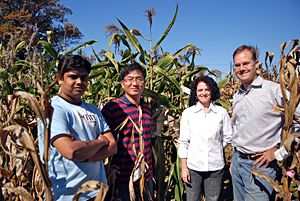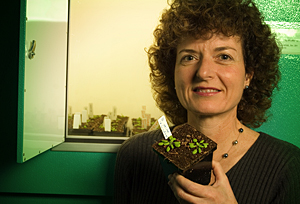

- Rozovsky wins prestigious NSF Early Career Award
- UD students meet alumni, experience 'closing bell' at NYSE
- Newark Police seek assistance in identifying suspects in robbery
- Rivlin says bipartisan budget action, stronger budget rules key to reversing debt
- Stink bugs shouldn't pose problem until late summer
- Gao to honor Placido Domingo in Washington performance
- Adopt-A-Highway project keeps Lewes road clean
- WVUD's Radiothon fundraiser runs April 1-10
- W.D. Snodgrass Symposium to honor Pulitzer winner
- New guide helps cancer patients manage symptoms
- UD in the News, March 25, 2011
- For the Record, March 25, 2011
- Public opinion expert discusses world views of U.S. in Global Agenda series
- Congressional delegation, dean laud Center for Community Research and Service program
- Center for Political Communication sets symposium on politics, entertainment
- Students work to raise funds, awareness of domestic violence
- Equestrian team wins regional championship in Western riding
- Markell, Harker stress importance of agriculture to Delaware's economy
- Carol A. Ammon MBA Case Competition winners announced
- Prof presents blood-clotting studies at Gordon Research Conference
- Sexual Assault Awareness Month events, programs announced
- Stay connected with Sea Grant, CEOE e-newsletter
- A message to UD regarding the tragedy in Japan
- More News >>
- March 31-May 14: REP stages Neil Simon's 'The Good Doctor'
- April 2: Newark plans annual 'wine and dine'
- April 5: Expert perspective on U.S. health care
- April 5: Comedian Ace Guillen to visit Scrounge
- April 6, May 4: School of Nursing sponsors research lecture series
- April 6-May 4: Confucius Institute presents Chinese Film Series on Wednesdays
- April 6: IPCC's Pachauri to discuss sustainable development in DENIN Dialogue Series
- April 7: 'WVUDstock' radiothon concert announced
- April 8: English Language Institute presents 'Arts in Translation'
- April 9: Green and Healthy Living Expo planned at The Bob
- April 9: Center for Political Communication to host Onion editor
- April 10: Alumni Easter Egg-stravaganza planned
- April 11: CDS session to focus on visual assistive technologies
- April 12: T.J. Stiles to speak at UDLA annual dinner
- April 15, 16: Annual UD push lawnmower tune-up scheduled
- April 15, 16: Master Players series presents iMusic 4, China Magpie
- April 15, 16: Delaware Symphony, UD chorus to perform Mahler work
- April 18: Former NFL Coach Bill Cowher featured in UD Speaks
- April 21-24: Sesame Street Live brings Elmo and friends to The Bob
- April 30: Save the date for Ag Day 2011 at UD
- April 30: Symposium to consider 'Frontiers at the Chemistry-Biology Interface'
- April 30-May 1: Relay for Life set at Delaware Field House
- May 4: Delaware Membrane Protein Symposium announced
- May 5: Northwestern University's Leon Keer to deliver Kerr lecture
- May 7: Women's volleyball team to host second annual Spring Fling
- Through May 3: SPPA announces speakers for 10th annual lecture series
- Through May 4: Global Agenda sees U.S. through others' eyes; World Bank president to speak
- Through May 4: 'Research on Race, Ethnicity, Culture' topic of series
- Through May 9: Black American Studies announces lecture series
- Through May 11: 'Challenges in Jewish Culture' lecture series announced
- Through May 11: Area Studies research featured in speaker series
- Through June 5: 'Andy Warhol: Behind the Camera' on view in Old College Gallery
- Through July 15: 'Bodyscapes' on view at Mechanical Hall Gallery
- More What's Happening >>
- UD calendar >>
- Middle States evaluation team on campus April 5
- Phipps named HR Liaison of the Quarter
- Senior wins iPad for participating in assessment study
- April 19: Procurement Services schedules information sessions
- UD Bookstore announces spring break hours
- HealthyU Wellness Program encourages employees to 'Step into Spring'
- April 8-29: Faculty roundtable series considers student engagement
- GRE is changing; learn more at April 15 info session
- April 30: UD Evening with Blue Rocks set for employees
- Morris Library to be open 24/7 during final exams
- More Campus FYI >>
3:34 p.m., Oct. 30, 2008----University of Delaware scientists, in collaboration with researchers from the University of Arizona and South Dakota State University, have identified unusual differences in the natural mechanisms that turn off, or “silence,” genes in corn.
The discovery, which was made by comparing the impact of inactivating a gene that occurs in both corn and in the much-studied laboratory plant Arabidopsis, provides new insight into how one of the world's most important crops protects itself from mutation-causing mobile DNA elements and viruses.
The research was led by Blake Meyers, associate professor of plant and soil sciences, and Pamela Green, Crawford H. Greenewalt Chair and professor of plant and soil sciences and marine bioscience, and their laboratory groups at the Delaware Biotechnology Institute, a major center for biotechnology and life sciences research at the University of Delaware.
Collaborating with the University of Delaware team were Vicki Chandler, the Carl E. and Patricia Weiler Endowed Chair for Excellence in Agriculture and Life Sciences Regents' Professor at the University of Arizona, and Yang Yen, a professor at South Dakota State University.
The results were published in the Proceedings of the National Academy of Sciences of the United States of America.
Studies of Arabidopsis thaliana, a small flowering plant of the mustard family that is easy to grow in the lab, have provided a lot of what scientists know about gene silencing in plants.
An important key to the process is short sequences of ribonucleic acids known as “small RNAs” which act like biochemical switches that shut off genes, thus playing a fundamental role in plant development. Understanding how small RNAs work is a continuing quest for geneticists seeking to breed plants with improved crop yields, disease resistance and other characteristics.
Previously, the Meyers and Green labs had studied Arabidopsis plants with nonfunctional versions of a gene known as RNA-dependent RNA polymerase 2 (RDR2). Without an active copy of this gene, the plants were unable to produce a major class of small RNAs, which act to stabilize and protect genes on the chromosomes.
In that prior work, Meyers and Green took advantage of the nonfunctional gene to study microRNAs, an interesting type of small RNA that is usually “masked” by the major class of small RNAs produced by RDR2.
Independently of the UD groups, Chandler and her team at the University of Arizona had identified from corn an orthologous gene--a gene that has the same function in different organisms. In corn, this gene, which the Chandler lab found, is called the mediator of paramutation (MOP1). Its equivalent in Arabidopsis is the RDR2 gene.
Because the RDR2 and MOP1 genes should both produce the “protective” set of small RNAs, the research groups decided to collaborate to see if the small RNAs in corn behave the same way they do in Arabidopsis. The hypothesis was that the result would be the same in the two plant species, and the lab groups could use the MOP1 corn plants to focus their studies on the harder-to-examine microRNAs, as they had done previously in Arabidopsis.
“Yet we found something that had not been observed before in this plant--an odd class of small RNAs,” Meyers said. “I think it's pretty neat to work in a more complex system like corn and see things that Arabidopsis hadn't shown us,” he noted.
Using a technique known as sequencing by synthesis (SBS), provided by Illumina in Hayward, Calif., coupled with state-of-the-art bioinformatics in Meyers' lab, the research team found that the MOP1 and RDR2 genes are not fully equivalent based on an assessment of small RNA complexity.
The researchers found that there are lots more RNAs of an unusual class known as “small interfering RNAs” in corn than there are in Arabidopsis.
“This class of RNAs mainly functions to repress repetitive sequences, including mobile DNA elements called transposons,” Meyers said. “Thus, small interfering RNAs act to protect the genome,” he noted.
“Corn contains an extra layer of protective small RNAs that had not been observed in Arabidopsis, so there must be additional genes other than MOP1 that produce this,” Meyers said.
The scientific community is sequencing the corn genome now, Meyers said. Once the genome is available, the work of matching up small RNAs to specific traits in corn will be much easier, he noted.
“This research is helping us to better understand the biology of corn--one of the most important plants in the world--and gives us new avenues for exploring a novel class of small RNAs,” Meyers said.
Article by Tracey Bryant
Photos by Danielle Quigley and Kathy Atkinson


